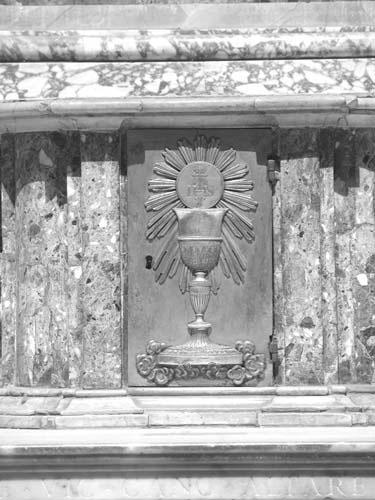
7 minute read
Chapter 6: The Serpent Sword
from SECRET SOCIETIES: GARDINER'S FORBIDEN KNOWLEDGE, REVELATIONS ABOUT FREEMASONS, TEMPLARS, NAZIS,
E 6
The Serpent Sword
Advertisement
When I was first invited to join a certain secret society—one that shall not be found on the Internet—I was amazed at the imagery and symbolism that surrounded me. On the night of initiation, one particular device set itself apart from all else—the sword.
I was in a long hall that looked like an old chapel, with wooden beams and high windows. The lower parts of the windows were now boarded with finely painted oak—murals depicting the trials and tribulations of a medieval warrior monk. At the end of the hall were large satin curtains of deep red. On either side of me stood a line of men all dressed in white robes, holding aloft gleaming silver swords, and at the end the Grand Master beckoned me “come.” As I walked, the swords fell behind me and were placed zig-zag fashion across the floor so that my path behind was no longer one I could walk. This is a symbolic device, a truth we all must learn—attempting to rewalk the path we have already trodden is pointless.
Eventually, I reached the Grand Master and we followed a ritual that can be dated back many hundreds of years. I bowed low and accepted my pledge as the Master’s sword symbolically killed my old self so that I might be born anew.
The sword here is used as a device to bring to life the symbolic aspects of a hidden Gnostic truth and a psychology as relevant today as ever. It has been this way for an awfully long time, and it
is interesting, therefore, to discover that King Arthur himself, a symbol of so many things, also held the sword of truth, energy, and wisdom.
In The Quest of the Holy Grail, a uniquely alchemical tale created by secret orders, the sword is seen as a fiery serpent, symbolic of energy. It is the sword of King David or made by the wise Solomon with a pommel stone of all the colors of the Earth and two rib hilts, one made from the fish of the Euphrates, and the other, the serpent.
It is said to resemble the sword of Arthur, which itself is said to be serpentine in the Dream of Rhonabwy. When Arthur’s sword is drawn it was said that two flames of fire burst out of the jaws of the two serpents, and so wonderful was the sword that it was hard for anyone to gaze at it. It is necessary for Arthur to maintain ownership of the sword, whether it is the sword from the stone or Excalibur, as it ensures his victory and his life. Malory indicates again the brightness of the sword and its fiery aspect, writing: “but it was so bright in his enemies’ eyes, that it gave light like thirty torches.” But the sword in the stone does not last long, and the Lady of the Lake gives Arthur his Excalibur, and also a serpent scabbard, which ensures eternal life. Malory states quite clearly, “...for whiles ye have the scabbard upon you, ye shall never lose no blood, be ye never so sore wounded; therefore keep well the scabbard always with you.” It is only when Arthur’s half sister Morgan le Fay steals the scabbard and replaces it that Arthur becomes susceptible to the deadly blows of Mordred. The once-prized sword is then returned to the water, the home of the Lady of the Lake—the serpent spirit.
There is a remarkable resemblance between the tales of Arthur’s sword and Chinese legend. A hero from the 6th century B.C. named Wu Tzu-hsu threw his sword into a river. It shot forth like a spirit-glow, sparkling brightly as it thrice sank and thrice came to the surface with a great gush and then hovered above the water. The god of the river…heard the swords roar…he rolled in the waters in a great and frothing frenzy…. Dragons raced along the waves and leaped out of
the water. The river god held the sword in his hand and, frightened, told Wu Tzu-hsu to take it back. (Mair 1983, 141 and 286)
This story, related in the 8th century A.D., simply cannot differ from Malory’s tale of the sword. In China there were tales of great swords such as Dragon Spring and others that leap into waters surrounded by dragons, which churn up the water. Wu Tzu-hsu’s sword is also called Dragon Spring.
But is there any archaeological evidence for the existence of a real sword or swords that were seen as serpents? Well, I just so happened to find such evidence in the Catalogue of The Fourteenth Park Lane Arms Fair. Lee A. Jones authored a fascinating article titled, “The Serpent in the Sword: Pattern-Welding in Early Medieval Swords,” which immediately made the hairs on the back of my neck tingle. (www.vikingsword.com/serpent.html)
E
Medieval snake sword
The sword first appeared around 4,000 years ago and immediately became the preeminent weapon, preferred by the warrior class. Recent metallurgical studies have shown how complex piled structures or layers improved the sword from as early as 500 B.C. in Celtic artifacts. Little wonder that the smithy was an important part of legend and folklore, as the skill implied in the making
of these swords is substantial: Several rods are welded together down the length of the blade, joining the various levels of metal together. It was then heated and pounded into shape. Swordmaking was an awesome task. Smaller rods that were carburized (improved carbon) were introduced to increase the hardness. This formed steel, an alloy of iron with small amounts of carbon, was introduced into the edges of the blade because it was stronger and more effective.
Through the 5th to 10th centuries A.D.—the approximate period of King Arthur—sword smiths actually managed to manipulate this piled structure to create wonderful designs within the blade. The method remained virtually unchanged even into the 20th century, as can be seen with the daggers of the Nazis, who utilized it extensively.
The patterns are seen via the varying degrees of trace elements within the different rods, showing alternating shades. The rods are invariably twisted down the shaft, forming a spiral effect. These “twisted” swords are seen as early as the 1st century B.C. in the La Tene period, although more effectively used from the 3rd and 5th centuries—the exact early period of Arthur. Cassiodorus was a secretary of Theodoric, and in A.D. 520 he wrote to a northern Germanic tribe regarding a gift of words praising their skills, especially the shadows and colors seen in the blades, which he likened to “tiny snakes.” The 10th century Kormaks Saga says this concerning the sword Skofnung: …a covering goes with it and thou shall leave it quiet; the sun must not shine on the upper guard, nor shall thou comest to the fighting place, sit alone, and there draw it. Hold up the blade and blow on it; then a small snake will creep from under the guard; incline the blade and make it easier for it to creep back under the guard.
It is the considered opinion of some scientists that this implies that the dew would reveal the pattern of the serpent upon the sword, giving the impression that a serpent is emerging from the sheath.
This inclusion of the serpent in the blade was eventually replaced with iron inlaid letters and symbols, and Christian phrases
such as In Nomine Domini (“In the name of the Lord”). The remarkable archaeological fact of serpents appearing in the designs of 5th century swords links perfectly with the time of Arthur. As the Pendragon or Head/Chief Dragon Lord, he would certainly have been seen with such a device, and in the stories mentioned previously, there are textual links in the legend. Could it be that the tales of Arthur and his serpentine or dragon swords were based upon reality?
And so, coming full circle, I am drawn back to that first initiation years ago and the sword that was bestowed upon me and which is now back with the order. It stood nearly 5 feet with a gold pommel of writhing dragons. The silver sheen of the blade when turned in the light would reveal a beautiful pattern of two entwined serpents, heads coming closer together as they raced toward the tip.
The sword, as a fighting tool, has been with man for more than 4,000 years, and as such it has crept into the comradeship of the warrior elite that could afford its luxury. Symbolism of wisdom, energy, and illumination has been melded in with the steel structure in the same way that the sword has been melded into the myths and tales that were themselves stories of inner light. The shining sword is symbolically utilized throughout secret societies today and has been so for hundreds of years—creating a bond between man today and man yesterday.
This page intentionally left blank







